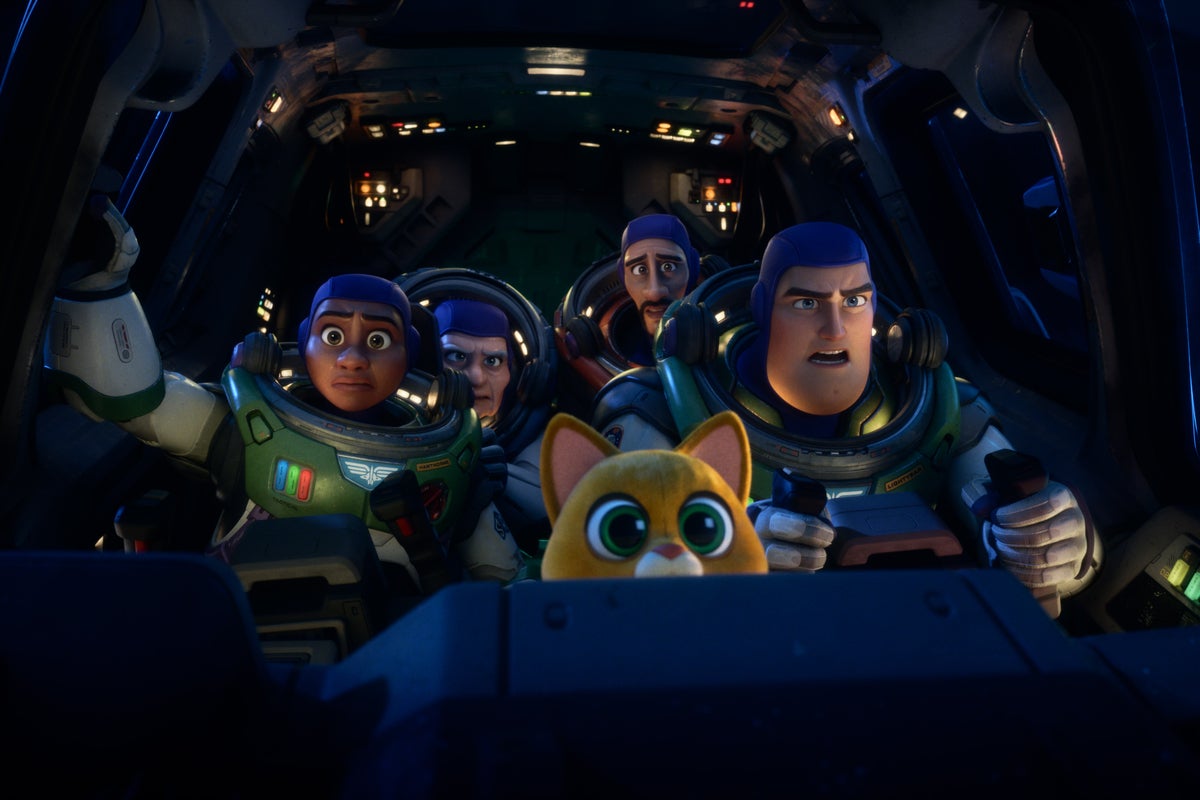“Toy Story 3 is the saddest one. Convince me otherwise!” yelled one wiseacre, who looked to be in about the fourth grade, during the pre-show audience warmup at the all-ages advance screening of Lightyear I attended. A young man—maybe a Pixar employee, maybe a local emcee or children’s entertainer—had come out to work the crowd, tossing out trivia questions about the four previous movies in the Toy Story franchise and riffing with middling success on the replies. This kid’s unsolicited comment was the hostility-free version of a heckle.
It was a sweet, if retrospectively ironic, way to kick off the showing of one of the first Pixar films in years, and one of only a handful in the studio’s 27-year history, to feel first and foremost like a piece of well-engineered corporate IP. That kid had it wrong: Though Toy Story 3 may draw forth more tears from audiences—I’ll never forget my then-thirtysomething editor sobbing beside me through that final scene—it is Lightyear that, looked at from a broader perspective, is the saddest of the Toy Story movies. If the point of the original was that a child’s love can rescue even the most mass-produced consumer product from meaninglessness, Lightyear is a commercially motivated attempt to reverse-engineer the piece of disposable mass culture that inspired that product in the first place.
“In 1995,” reads an opening title card, “a boy named Andy got a Buzz Lightyear toy for his birthday. It was from his favorite movie. This is that movie.” The film that follows is neither an affectionate pastiche nor a sharp-witted parody of the kind of big-screen space opera that might have entranced a small boy of that era. It’s just … an average-to-pretty good version of the kind of generic sci-fi adventure that has played on screens big and small for decades, with a few updated touches for the 21st century. In the role of Buzz Lightyear, the Leno-jawed space ranger voiced by Tim Allen in previous films, is Chris Evans of Captain America fame. The central joke of Buzz-the-toy’s character was always his self-serious refusal to grasp that he was not, in fact, a born-to-lead starship pilot but merely a store-bought plaything. When Buzz instead becomes the CGI equivalent of a live-action movie hero, that existential conflict disappears, replaced by a less interesting struggle to accept his human limitations.
Those limitations are on full display as the movie begins: Co-commanding a mission with his friend and mentor Alisha Hawthorne (Uzo Aduba), Buzz lets his hubris lead him into a fatal mistake. His insistence on pulling off a hot-dogging piloting stunt (the same one that inexplicably worked for Tom Cruise in the new Top Gun movie) results in him damaging the ship’s fuel cell, trapping the ship’s crew on a remote planet. Driven by a combination of guilt and monomaniacal dedication, Buzz then devotes the next 60-plus years to testing new sources of hyperspeed fuel so that he can get his team back home—the tearjerking twist being that those six decades pass, for him, as if they were mere hours. Every test mission he flies slows down the passage of time for him in relation to his colleagues. Alisha gets married (to a woman, seen only in a brief montage sequence that has nonetheless gotten Lightyear banned in some countries), has a child and then a grandchild, and finally grows old and dies, all in the course of what Buzz experiences as a few brief visits home. This story element, familiar from movies from 2001: A Space Odyssey to Interstellar to Synecdoche, New York, could have been the jumping-off point for a meditation on the ephemerality of human life and the mystery of time’s passage, but the movie, like the un-introspective Buzz himself, seems content to settle for a few moments of Michael Giacchino–scored melancholy.
Buzz eventually teams up with Alisha’s granddaughter, spunky astronaut trainee Izzy (Keke Palmer), aided by an ubercompetent robot cat named Sox (delightfully voiced by Pixar animator Peter Sohn) and a pair of ragtag trainees (Taika Waititi and Dale Soules) to fight off the film’s too-late-arriving and distinctly underwhelming villain, a giant robot named Zurg (voiced by James Brolin).* Even less successful is a confusing third-act twist involving a visit from Buzz’s time-traveling future self. After a spate of highly original, heartfelt Pixar entries like Luca and Turning Red, Lightyear feels like a disheartening step backward—not quite a Cars 2–level pander to greedy toy merchandisers, but still a movie that was made because it could be, not because it had to be.
[Read: Lightyear’s Big Twist Has a Surprise About One of Toy Story’s Oldest Villains.]
Angus MacLane, who co-directed the Finding Nemo sequel Finding Dory, directed and co-wrote this competent but magic-free sequel. The familiar Pixar craft elements are all in place: Giacchino’s score soars movingly or bounces merrily, as required by the story, and the animation provides witty character detail (Sox the robo-cat’s tail doubles as an all-purpose USB cable) as well as breathtaking outer space vistas. Lightyear’s message, about giving up on heroic world-saving fantasies and learning to work as part of a team, is as uncynical and wholesome as a parent could wish for, and family audiences with no grand expectations that their Saturday afternoon matinee viewing constitute great art will have a fine time watching Buzz and his pals zip from infinity to beyond and back. But there’s a rueful irony to the fact that it’s this supposedly human inspiration for the beloved toy who feels more like a plastic action figure.
Correction, June 17, 2022: This article originally misstated who voiced Zurg. It was James Brolin, not his son Josh.
